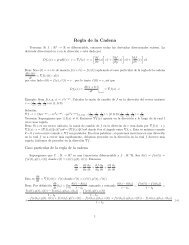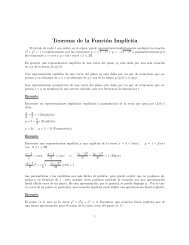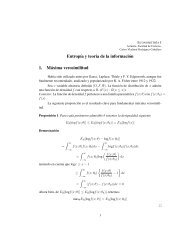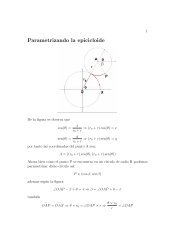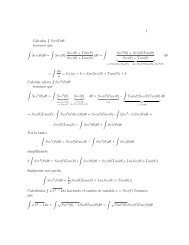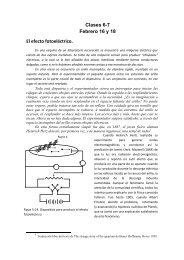"Surely You're Joking, Mr. Feynman!" - unam.
"Surely You're Joking, Mr. Feynman!" - unam.
"Surely You're Joking, Mr. Feynman!" - unam.
Create successful ePaper yourself
Turn your PDF publications into a flip-book with our unique Google optimized e-Paper software.
along, working on this mechanical computer, without any interference.<br />
One day the lieutenant came by, and asked us a simple question: "Suppose that<br />
the observer is not at the same location as the gunner how do you handle that?"<br />
We got a terrible shock. We had designed the whole business using polar<br />
coordinates, using angles and the radius distance. With X and Y coordinates, it's easy to<br />
correct for a displaced observer. It's simply a matter of addition or subtraction. But with<br />
polar coordinates, it's a terrible mess!<br />
So it turned out that this lieutenant whom we were trying to keep from telling us<br />
anything ended up telling us something very important that we had forgotten in the<br />
design of this device: the possibility that the gun and the observing station are not at the<br />
same place! It was a big mess to fix it. Near the end of the summer I was given my first<br />
real design job: a machine that would make a continuous curve out of a set of points <br />
one point coming in every fifteen seconds from a new invention developed in England<br />
for tracking airplanes, called "radar." It was the first time I had ever done any mechanical<br />
designing, so I was a little bit frightened.<br />
I went over to one of the other guys and said, "<strong>You're</strong> a mechanical engineer; I<br />
don't know how to do any mechanical engineering, and I just got this job. . ."<br />
"There's nothin' to it," he said. "Look, I'll show you. There's two rules you need to<br />
know to design these machines. First, the friction in every bearing is soandso much, and<br />
in every gear junction, soandso much. From that, you can figure out how much force<br />
you need to drive the thing. Second, when you have a gear ratio, say 2 to 1, and you are<br />
wondering whether you should make it 10 to 5 or 24 to 12 or 48 to 24, here's how to<br />
decide: You look in the Boston Gear Catalogue, and select those gears that are in the<br />
middle of the list. The ones at the high end have so many teeth they're hard to make, if<br />
they could make gears with even finer teeth, they'd have made the list go even higher.<br />
The gears at the low end of the list have so few teeth they break easy. So the best design<br />
uses gears from the middle of the list."<br />
I had a lot of fun designing that machine. By simply selecting the gears from the<br />
middle of the list and adding up the little torques with the two numbers he gave me, I<br />
could be a mechanical engineer!<br />
The army didn't want me to go back to Princeton to work on my degree after that<br />
summer. They kept giving me this patriotic stuff, and offered a whole project that I could<br />
run, if I would stay.<br />
The problem was to design a machine like the other one what they called a<br />
director but this time I thought the problem was easier, because the gunner would be<br />
following behind in another airplane at the same altitude. The gunner would set into my<br />
machine his altitude and an estimate of his distance behind the other airplane. My<br />
machine would automatically tilt the gun up at the correct angle and set the fuse.<br />
As director of this project, I would be making trips down to Aberdeen to get the<br />
firing tables. However, they already had some preliminary data. I noticed that for most of<br />
the higher altitudes where these airplanes would be flying, there wasn't any data. So I<br />
called up to find out why there wasn't any data and it turned out that the fuses they were<br />
going to use were not clock fuses, but powdertrain fuses, which didn't work at those<br />
altitudes they fizzled out in the thin air.<br />
I thought I only had to correct the air resistance at different altitudes. Instead, my<br />
job was to invent a machine that would make the shell explode at the right moment, when




